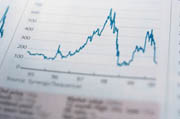Baby boomers are amassing trillions of dollars in stocks, bonds and mutual funds for retirement. But when they quit work and start selling those assets, will there be enough buyers? Or will supply outstrip demand, driving down prices and leaving the retirees with far less than they had expected? These were among the issues Wharton finance professor Jeremy Siegel addressed during a presentation at Wharton on May 15 in which he also talked about the current stock and bond markets, worker productivity and growth in developing countries.
Some of these topics will be addressed in Siegel’s upcoming book, entitled The Future of Investing, due out in early 2005. It will follow Siegel’s best seller, Stocks for the Long Run, published in 1994 and later updated. That book argued that stocks are the most profitable long-term investment – providing a premium that offsets stocks’ greater short-term risks relative to bonds and cash. From 1802 through 2003, the broad stock market provided “real” returns – adjusted for inflation – averaging 6.8 percent a year. “On average, you have doubled your purchasing power every decade in the stock market,” he said during his talk, adding that while stocks have failed to meet that average over a few long periods, performance has been remarkably consistent.
The downturn that began when the tech-stock bubble burst in 2000 merely returned the market to normal patterns following a period, from 1981 through 1999, of outsized returns – 13.6 percent a year. “We are right on the trend line,” he said.
Siegel has long argued that stocks should form the core of most small investors’ retirement portfolios, since long-term bonds have provided average real returns of only 3.5 percent. Bonds did considerably better in the ‘80s and ‘90’s, averaging 8.4 percent a year. But that was due to bond-price increases driven by falling interest rates; now, and for the foreseeable future, rates are likely to rise, driving bond values down. “I think the great bull market in bonds is over,” Siegel said. Millions of investors have embraced Siegel’s view, amassing nearly $3.9 trillion in mutual funds containing stocks.
Siegel’s new book will attempt to answer a question often asked by readers of the previous one: “Which stocks for the long run?” Researching that question, he studied the performance of the 50 largest U.S. stocks from 1950. While many investors would assume hot, cutting-edge firms of the era, such as IBM, would top the list, Siegel said the best were more prosaic firms, such as Kraft Foods, Standard Oil of New Jersey (which became Exxon-Mobil), and Coca-Cola. All of these today make essentially the same products they did in 1950. “I think the thing that this best shows you is: if you’ve got a winner, you stay with it,” he said. One of the best long-term performers has been Philip Morris, the tobacco company. It returned more than 17 percent a year from 1925 through 2003, compared to just over 9 percent for the Standard & Poor’s 500. They key to the company’s results was its consistently large dividends – common among top stocks.
Siegel found that new S&P 500 companies generally did not perform as well as older ones. Investor enthusiasm for new offerings often causes those stocks to be priced too high at the start, and long-term performance is undercut when they settle to more rational prices, he said. Long-term investors would thus be wise to build a core holding of proven, dividend-paying companies with established products.
But the value of any holding depends on buyers’ demand, and the aging of the U.S. population means there could be more sellers than buyers, which tends to depress stock prices. This would reverse the baby boomer’s previous experience: an unusually large group of buyers that drove up demand and helped propel prices upward.
The retirement-funding challenge for the boomer generation will be aggravated by longer life expectancies. In 1950, the average American lived just 1.6 years in retirement. Today the figure is 14.4 years, and it will get longer unless people retire later. There also will be fewer working-age people to support retirees by paying into Social Security and purchasing older people’s investments. In 1950, there were seven workers per retiree. Today there are five, and there are likely to be only 2.6 in 2050, Siegel said. Some other developed countries will have it even worse, with Italy projected to have just one worker per retiree by mid-century. “This means that we in the developed world face some very serious questions,” Siegel said.
As life expectancy reaches the mid-80s, the retirement age may have to be pushed as high as 72 – not likely to be a popular proposal. “If you ask the average American when he or she wants to retire, the answer is yesterday,” Siegel said.
Gains in worker productivity can help offset the reduction in workers per retiree. But even if annual productivity growth rose to a steady 3.5 percent a year, compared to the long-term average of 2.2 percent, this would fund only a couple more years of retirement needs, Siegel said, adding that a sustained 3.5 percent level is very unlikely. Immigration may produce more workers, he added, although it would take hundreds of millions of immigrants to solve the worker-retiree disparity over the next half century.
“But there’s hope,” he stated, arguing that continued economic growth in developing countries could solve the problem by providing young workers. “Throughout history, the old sell their assets to the young. Centuries ago, it was within a family or a clan. Now it [is between] countries … We will be selling our assets to the developing world.”
By mid-century, the developing countries should account for 75 percent of the world’s gross domestic product, up from 25 percent today, he predicted. The population of India and China, among the countries with the fastest economic growth, will be eight times that of the U.S. Those huge populations will make the products that the U.S. will stop producing, and consume those that the U.S. will continue to provide. The U.S., said Siegel, should continue to enjoy competitive advantages in health care, education, infrastructure building, financial services and technological innovation.
With growing wealth, the big, young populations of the developing world will be eager to take baby boomers’ assets off their hands, helping to avert a collapse in stock prices, he said, noting that in the long run, stocks are likely to provide real returns of about 6 percent, just a shade under the historical average, he said.
Though the price-to-earnings ratio of the S&P 500 is now in the low-20s, compared to a long-term average of about 15, Siegel does not believe stocks are over-priced today. Factors such as greater securities liquidity, tax-law changes and the taming of the business cycle have made stocks less risky, and a P/E of 20 or so should be considered the norm, he said.
If corporate earnings come in as expected, the S&P 500 would be properly valued between 1000 and 1250 at current P/E levels. With the index at about 1100, a move to 1250 by year-end would be a 12 percent gain. “I know there are a lot of uncertainties; there always are in the market,” Siegel said. “[But] we don’t have to worry about this aging situation.”



